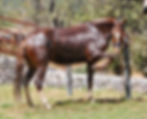
PERU'S BEST KEPT SECRET
The Peruvian Paso Horse
As its name indicates the Peruvian Paso horse is native to Peru. It is a direct descendant of the Spanish horse brought to America by Christopher Colombus and the Conquistadores.
Because of its isolation for almost 500 years, the Peruvian Paso horse has evolved as one of the purest breeds in the world and as a unique entity in the horse kingdom. The existence of this breed has been called "the greatest triumph of genetic selection ever achieved by a group of breeders". The trademark of this breed is a special, inherited, and completely natural four-beat lateral gait called Paso Llano (a contraction of Paso Castellano). Thanks to its exquisite, innate and ground-covering gait, the Peruvian Paso horse is undoubtedly the smoothest riding horse in the world.
Origin
Modern Peruvian horse descends from the horses introduced into Peru by the Spanish in the sixteenth century. The Spanish Conquistadors brought with them both Hacks (amblers) and Chargers (trotters) of the same breed to the New World, and as recorded in the Archives of the Indios, the Spanish horse, the classic Andalusian, was a breed consisting of Galician (Celtic) horses of the North, Sorraia, and Barb of the area that is known today as Morocco, Tunes and Libya.
The experts agree that the first major shipment of horses to the New World was in 1493 on Columbus’s second voyages. Francisco Pizarro and his 160 men who captured the Inca Atahualpa in November 1532 brought 62 horses with them. To these were added the 84 animals brought by Diego de Almagro after the imprisonment of the Inca, the horses belonging to the armies of Sebastian de Benalcazar and Hernando de Soto. These horses were the original ancestors of the Peruvian horse.
It is interesting to note here that during the last 500 years of Spanish history, successive Royal Edicts for its breeding brought about substantial differences in the present-day Andalusian horse and that which accompanied the Spanish Conquistadores. Particularly during the reign of Phillip II, the Spanish horses were cross-bred with German and Danish horses resulting in significant changes in their basic characteristics.
In Peru, the ‘original’ Andalusian horse brought by the Spaniards has kept most of the characteristics that made the Andalusians so valuable during the conquest of South America.
No outside blood has been introduced into the Peruvian breed, as there was no need to cross with other breeds to produce taller, heavier or faster horses, as was the case in other countries such as Mexico, Argentina or the United States.
The Peruvian Horse is a "hot blood," a purebred Spanish horse that was selectively bred for the amble after reaching the shores of Peru. The Peruvian horse was mainly developed to satisfy the need for a smooth and comfortable ride when overseeing plantations and travelling from one settlement to another. It was the only method of transportation that linked the valleys, provinces and villages of the coast as well as those from the Sierra. This explains some of its virtues such as stamina and resistance.
The Peruvian horses are also popular in other South American countries, especially in the north of Argentina, where they are highly appreciated and celebrated for their velvet-smooth gait, temperament and gentle disposition. In the old days, Peruvian merchandisers rode their Peruvian horses to Argentina and returned to Peru with Argentina's famous mules, which they sold to mining companies around the country.
Peru’s National Pride
A major principle with Peruvian breeders is that great Peruvian horses are born - not trained. Training is designed to bring out the animal's inherent ability but not modify it artificially.
To help ensure the retention of completely natural action and gait, no horse is allowed in the show ring with shoes or with hooves longer than 4 inches. All Peruvian breeders use the same training methods and equipment so that no advantage is gained through artificial devices or aids.
Today's Peruvian Paso horse is the result of 400-plus years of highly selective breeding. The breed is said to combine qualities that may be considered "contradictory." He is very high-spirited - though easy to handle while loose and relaxed in his movements. He has sparkling, brilliant action in the forelegs - yet he is extremely smooth and sure-footed. He has a refined appearance - yet he is powerful. This has been accomplished due to the intelligence, love, and devotion of innumerable breeders (many anonymous). Their arduous and silent work has made the Peruvian Paso horse one of the country's greatest treasures and a unifying source for its people.

Member of the Association of Breeders and Owners of Peruvian Paso Horses ACPCPP-Chilini, Arequipa
Our horses









“I do not think there is a Peruvian alive, nor will there ever be, that can beat a Thoroughbred at the mile, an Arabian at fifty miles or hold a 1200-pound steer like a Quarter Horse. Nor do I think there will ever be a better trail horse than the Peruvian. Sure-footed, safe, agile, smooth, willing and alert, their future is bright if we prove this IS a first-class trail horse to the world.”
- Julie Suhr
Equestrian Legend Julie Suhr has broken records in Endurance competitions. Since her first ride in the world-renowned 100-mile Tevis Cup (on a Peruvian Paso mare), Julie has completed twenty-two times out of twenty-nine starts. The one-hundred-mile, one-day Tevis Cup Ride is recognized as the most challenging endurance course on earth.


Elegance, nobility, resistance, tradition and silent ambassador.



